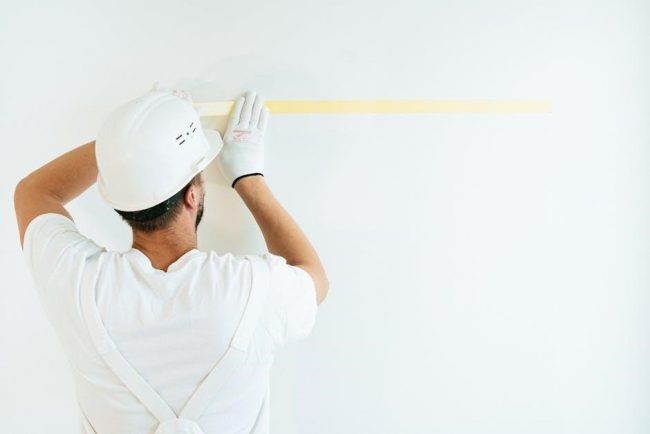Plantar fasciitis is a common foot condition causing pain in the heel and arch, often due to inflammation of the plantar fascia, a band of tissue supporting the foot.
Definition and Overview
Plantar fasciitis is a common condition characterized by inflammation or tearing of the plantar fascia, a band of tissue connecting the heel bone to the toes. It causes sharp, stabbing pain in the heel and arch, often worsening with the first steps of the day. The plantar fascia supports the arch and absorbs shock during walking, but repetitive stress or overuse can lead to irritation. This condition is frequently linked to activities involving prolonged standing, running, or wearing inadequate footwear. It is estimated to affect approximately 10% of the population, making it one of the most prevalent causes of heel pain.
Causes and Risk Factors
Plantar fasciitis arises from inflammation or microtears in the plantar fascia, often due to repetitive stress or overuse. Risk factors include age, obesity, and improper footwear. Activities like running or prolonged standing exacerbate the condition. Additionally, biomechanical issues such as flat feet or high arches can contribute. Tight calf muscles and Achilles tendons are also common predisposing factors. These elements collectively increase strain on the plantar fascia, leading to pain and discomfort. Addressing these underlying causes is crucial for effective treatment and prevention.
Symptoms and Diagnosis
Plantar fasciitis typically presents with stabbing or burning pain in the heel or arch, especially after rest or first steps in the morning. Pain may worsen during activity. The condition is diagnosed through clinical evaluation, including palpation of the plantar fascia and assessment of gait. Imaging, such as X-rays or MRIs, may be used to rule out fractures or tumors. Conservative treatments often alleviate symptoms, with 80-90% of cases resolving without surgery. Early detection and intervention are critical to managing discomfort and restoring mobility effectively.
What is Taping for Plantar Fasciitis?
Taping for plantar fasciitis is a non-invasive technique using adhesive tape to reduce pain and support the foot, aiding recovery and improving mobility during activities.
Taping techniques for plantar fasciitis involve applying adhesive tape to the foot to provide support, reduce strain, and alleviate pain. These methods are non-invasive and customizable to individual needs. Common approaches include the Low-Dye technique, which focuses on stabilizing the arch and redistributing pressure. Taping can be applied in various patterns to address specific symptoms, such as heel pain or fascial tightness. It is often used by athletes, physical therapists, and patients seeking immediate relief. While taping does not cure plantar fasciitis, it offers a practical solution to manage discomfort and improve mobility during daily activities or sports.
Low-Dye Taping: A Common Method
Low-Dye taping is a widely used technique for managing plantar fasciitis. It involves applying athletic tape in a specific pattern to support the arch and heel. The tape is placed from the ball of the foot to the heel, creating a “dye” effect. This method helps redistribute pressure, reducing strain on the plantar fascia. It is particularly effective for alleviating heel pain and providing arch support. The Low-Dye technique is popular among athletes and physical therapists due to its simplicity and effectiveness. Proper application ensures optimal benefits, making it a cornerstone of taping strategies for plantar fasciitis relief.
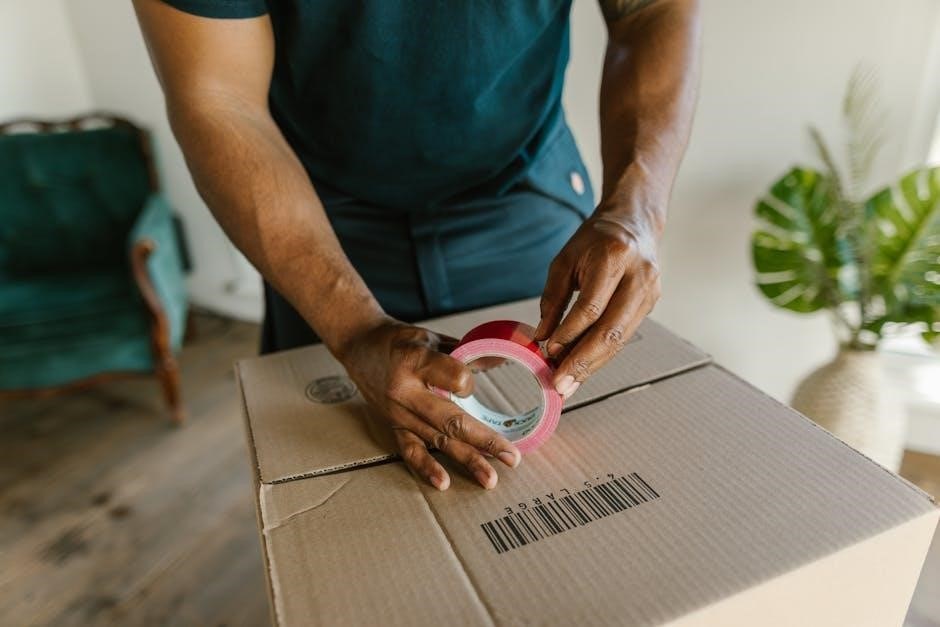
The Science Behind Taping
Taping works by redistributing tension in the plantar fascia, reducing strain and pain. It stabilizes the foot, improving biomechanics during movement.
How Taping Reduces Pain and Inflammation

Taping alleviates pain by redistributing pressure away from the plantar fascia, reducing strain on inflamed tissues. It stabilizes the foot, minimizing repetitive stress that exacerbates discomfort. The tape acts as an external support, limiting excessive stretching of the fascia and surrounding muscles. By reducing micro-tearing and inflammation, taping creates a more favorable environment for healing. Additionally, the subtle compression from the tape may enhance blood flow, promoting recovery. This mechanical support reduces nerve endings’ irritation, offering immediate pain relief and allowing individuals to remain active during treatment. Over time, this reduced stress can lead to decreased inflammation and faster resolution of symptoms.
Biomechanical Effects of Taping on the Foot
Taping alters the biomechanical function of the foot by providing structural support and modifying movement patterns. It helps restrict excessive pronation and supination, reducing abnormal stress on the plantar fascia. The tape acts as an external stabilizer, enhancing the natural arch support and improving the distribution of ground reaction forces. By limiting excessive stretching of the fascia, taping reduces the strain on the heel and midfoot during weight-bearing activities. This biomechanical adjustment promotes a more neutral foot alignment, which can prevent overloading of the plantar fascia and improve overall foot mechanics. These effects help create a more efficient and less stressful environment for healing.
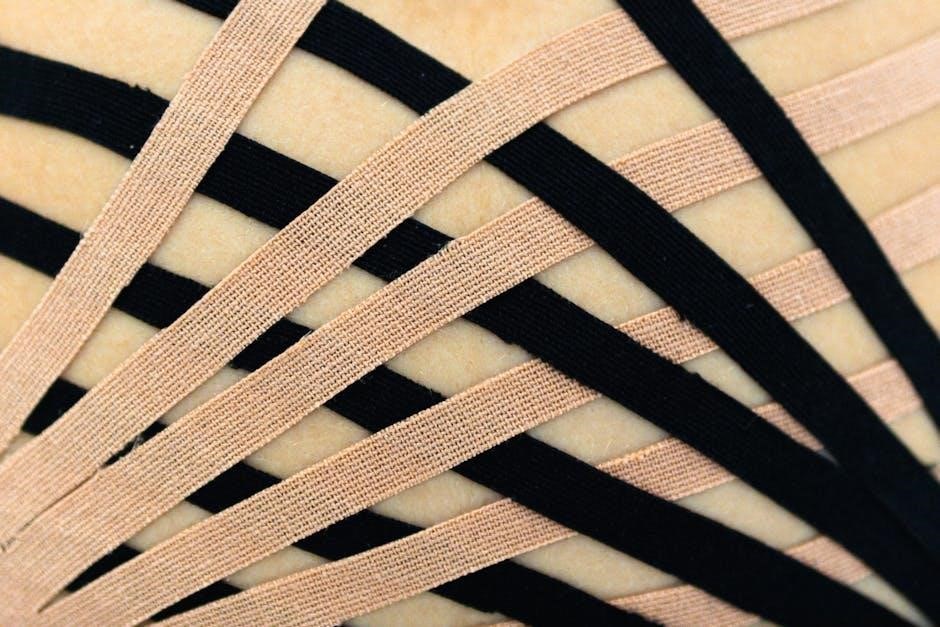
Benefits of Taping for Plantar Fasciitis
Taping provides immediate pain relief, enhances foot stability, and supports the plantar fascia during activities. It is a non-invasive, cost-effective solution that complements other treatments.
Short-Term Pain Relief
Taping for plantar fasciitis offers immediate and significant short-term pain relief by redistributing stress away from the inflamed plantar fascia. This method reduces tension on the fascia, minimizing discomfort during walking or standing. The tape provides external support, which helps alleviate pain caused by overuse or strain. Studies show that taping can reduce pain levels by up to 50% in acute cases, making it an effective first-line treatment. It is particularly beneficial for individuals with sudden onset of symptoms, as it allows for continued activity while promoting healing. This non-invasive approach is widely recommended for rapid symptom management.
Support and Stability for the Plantar Fascia
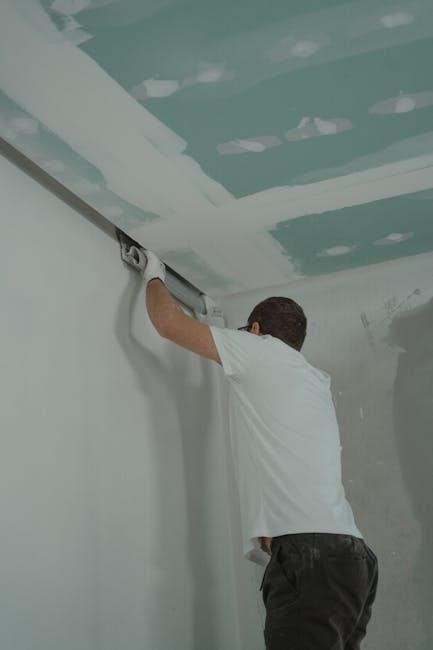
Taping for plantar fasciitis provides immediate support and stability to the plantar fascia, reducing strain during activities. By mechanically reinforcing the arch, it prevents excessive stretching and microtears. The tape helps redistribute pressure, offloading the fascia and promoting a natural gait. This added stability is crucial for healing, as it minimizes further irritation. Regular taping can enhance the fascia’s ability to withstand stress, offering both comfort and functional improvement. This method is especially beneficial for individuals with chronic plantar fasciitis, as it aids in maintaining proper foot mechanics and alleviating discomfort during daily activities.
Enhancing Mobility and Function
Taping for plantar fasciitis can significantly enhance mobility and function by allowing individuals to move more comfortably and perform daily activities with greater ease. By reducing pain and stiffness, taping enables patients to maintain their range of motion and engage in physical activities without discomfort. This is particularly beneficial for those with chronic plantar fasciitis, as it helps restore functional mobility. Taping also promotes proper foot mechanics, ensuring that the foot moves naturally during walking or running. Improved mobility not only boosts overall physical function but also supports long-term recovery by encouraging consistent movement and exercise.

Step-by-Step Guide to Low-Dye Taping
- Gather materials: athletic tape, scissors, and pre-wrap.
- Prepare the foot by cleaning and drying the skin.
- Apply the tape in strips, starting from the heel to the ball of the foot.
- Ensure a snug but comfortable fit to support the plantar fascia.
This straightforward process provides immediate support and relief.
Materials Needed
To perform Low-Dye taping for plantar fasciitis, you will need a few essential items. First, obtain high-quality athletic tape, preferably white or beige, which is breathable and gentle on the skin. Next, gather pre-wrap, a thin, elastic material used to cover and protect the skin before applying the tape. Scissors are necessary to cut the tape into appropriate lengths. Additionally, ensure the foot is clean and dry to enhance tape adhesion. Optional items like foam padding or heel cups can provide extra support. Having all materials ready ensures a smooth and effective taping process.
Preparation and Application
Start by washing and drying the foot thoroughly to ensure proper tape adhesion. Trim any thick calluses to prevent discomfort. Apply a thin layer of pre-wrap around the foot, avoiding tightness. Begin taping at the heel, placing a strip of athletic tape vertically around the back of the heel for support. Next, apply additional strips along the plantar fascia, from the heel to the ball of the foot, using gentle pressure. Finish by securing the tape at the top of the foot or around the ankle. Ensure the tape is snug but not constricting to allow for normal foot movement.
Removal and Maintenance
To remove the tape, gently peel it off from the edges, working slowly to avoid skin irritation. Using baby oil or adhesive remover can help dissolve the adhesive. After removal, wash the area with mild soap and water to prevent skin irritation. The tape should be reapplied every 1-2 days or when it loses its grip. Regularly inspect the tape for wear and tear. Allow the skin to rest without tape for a few hours daily to prevent irritation. Keep the foot dry to maintain tape adhesion, and consider using talcum powder to absorb moisture. Always have extra supplies on hand for reapplication.
Effectiveness of Taping
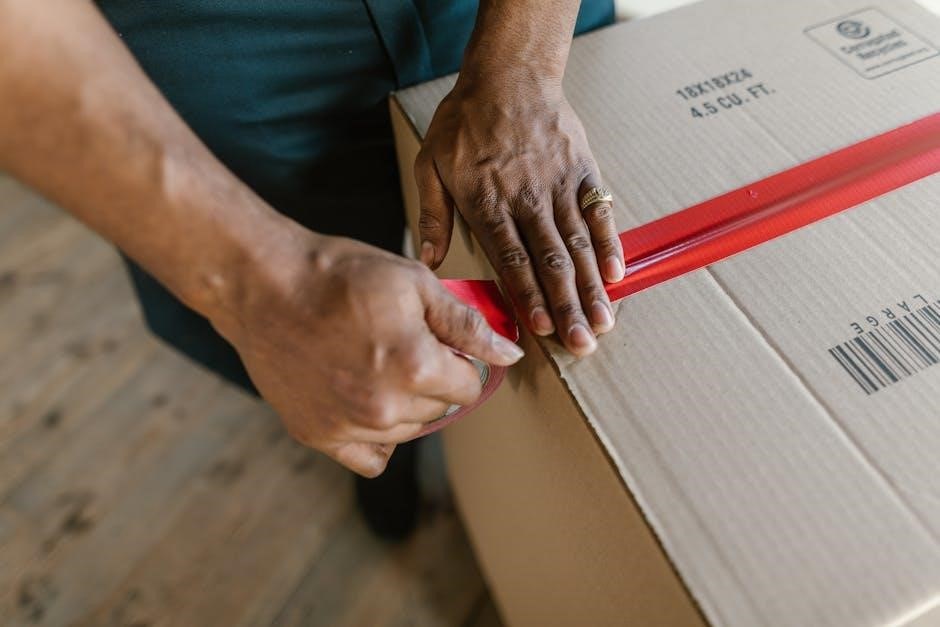
- Taping is a widely recommended method for managing plantar fasciitis symptoms.
- It offers immediate support and pain relief by redistributing pressure.
- Studies show taping reduces plantar fascia load, promoting healing.
- Combined with exercises and orthotics, taping enhances long-term outcomes.
Research Findings
Research consistently supports the effectiveness of taping for plantar fasciitis, with studies demonstrating significant reductions in pain and improvements in functional ability. A 2020 randomized controlled trial found that low-Dye taping reduced plantar fascia strain by 30% during weight-bearing activities. Another study highlighted that taping, when combined with stretching exercises, improved long-term outcomes. Meta-analyses reveal that taping is most effective in the acute phase, providing immediate symptom relief. However, its long-term benefits are less pronounced, suggesting it should be part of a broader treatment plan. Overall, taping is a cost-effective, non-invasive option with strong evidence supporting its use.

Comparison with Other Treatments
Taping for plantar fasciitis is often compared to other treatments like orthotics, night splints, and physical therapy. Studies show that taping provides comparable short-term pain relief to orthotics but may lack long-term efficacy. Night splints, while effective, can be bulky and less convenient. Physical therapy, though highly beneficial, requires consistent effort and time. Taping stands out for its affordability, ease of application, and non-invasive nature, making it a preferred first-line option. However, combining taping with other therapies often yields better outcomes. Research suggests that taping is most effective when used alongside stretching and strengthening exercises, enhancing its overall benefits for patients.
When to Use Taping
Taping is ideal for acute cases, providing immediate support and pain relief. It’s also beneficial during physical activity or prolonged standing to prevent further strain.
Acute vs. Chronic Plantar Fasciitis
Taping is particularly effective for acute plantar fasciitis, which involves sudden inflammation and pain. It provides immediate support, reducing stress on the plantar fascia and alleviating discomfort. For chronic cases, where pain persists for months, taping can help stabilize the foot during activities but should be combined with long-term treatments like stretching and orthotics. Acute cases benefit from taping as a first-line intervention, while chronic cases require a more comprehensive approach. Understanding the distinction is crucial for optimizing taping as part of a treatment plan tailored to the severity and duration of symptoms.
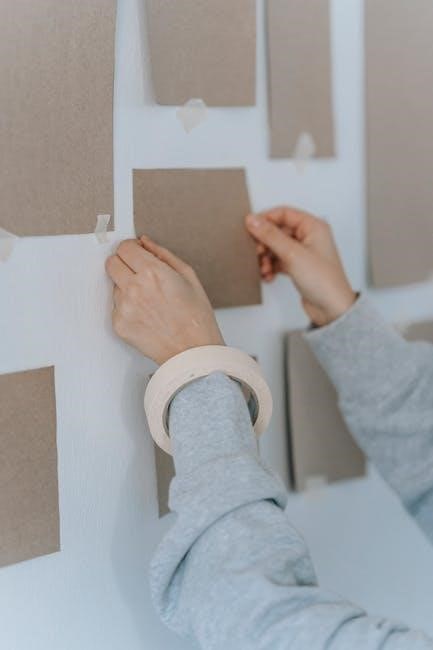
Combination with Other Therapies
Taping for plantar fasciitis is most effective when combined with other therapies. Stretching exercises, orthotics, and night splints are common complementary treatments. Taping provides immediate support, while stretching enhances flexibility and strengthens the foot muscles. Orthotics address biomechanical issues, and night splints promote healing during rest. Combining these therapies can accelerate recovery and improve long-term outcomes. Additionally, anti-inflammatory medications or ice therapy may be used to reduce pain and swelling. A multidisciplinary approach ensures comprehensive care, addressing both symptoms and underlying causes. Consulting a healthcare professional is essential to create a personalized treatment plan that integrates taping with other therapies effectively.

Limitations and Considerations
Taping for plantar fasciitis has limitations, including skin irritation, reduced mobility, and dependence on proper application; It does not address the root cause of the condition.
Potential Drawbacks of Taping
Taping for plantar fasciitis may cause skin irritation or allergic reactions due to the adhesive. It can also restrict natural foot movement, potentially altering gait patterns. Over-reliance on taping may delay addressing underlying issues like muscle weakness or poor footwear. Improper application can reduce effectiveness or even worsen discomfort. Additionally, taping does not promote long-term healing and should not be used as a standalone treatment. It is most effective when combined with stretching, strengthening exercises, and orthotic support. Despite its benefits, taping is not suitable for everyone, especially those with sensitive skin or certain medical conditions;
Contraindications
Taping for plantar fasciitis is not suitable for everyone. Individuals with severe foot ulcers, open wounds, or infections should avoid taping to prevent further irritation or complications. Those with circulatory disorders or neuropathy may also be at risk of impaired blood flow or nerve damage. Allergic reactions to adhesive tapes are another contraindication, as they can cause skin irritation or rashes. Additionally, taping is not recommended for individuals with certain medical conditions, such as severe arthritis or fractures, where immobilization could hinder recovery. Always consult a healthcare professional before using taping to ensure it is safe and appropriate for your specific condition.
Taping for plantar fasciitis is a valuable solution offering pain relief and support. It enhances mobility and aids recovery. Consult a professional for personalized advice and optimal results.
Taping for plantar fasciitis is a non-invasive, effective method to manage symptoms. It provides immediate support, reducing strain on the plantar fascia. Techniques like Low-Dye taping are widely used to alleviate pain and inflammation, promoting healing. Proper application is crucial for optimal results. Taping offers stability, enabling individuals to perform daily activities with less discomfort. It is often recommended alongside other therapies, such as stretching or orthotics. While taping is beneficial, it may not address underlying causes. Consulting a healthcare professional ensures proper technique and maximizes benefits. Overall, taping is a practical solution for managing plantar fasciitis, enhancing recovery, and preventing further issues.
Final Thoughts on Taping for Plantar Fasciitis
Taping for plantar fasciitis is a practical, non-invasive solution that offers immediate relief and support. It is particularly beneficial for reducing pain and enhancing mobility, especially when combined with other therapies. While taping does not cure the condition, it provides a cost-effective and easy-to-apply method for managing symptoms. For chronic cases, consulting a healthcare professional is essential to address underlying issues. Overall, taping is a valuable tool in the treatment plan, helping individuals regain comfort and functionality in their daily lives while promoting recovery.
